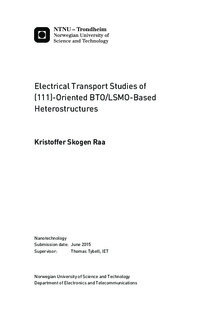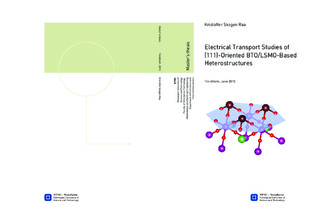| dc.description.abstract | Strain-induced magnetoelectric coupling in thin film heterostructures is a popular
topic in the emerging field of multiferroic materials. Normally such heterostructures
are grown with a (001) orientation, but (111)-oriented structures may exhibit in-
creased coupling at the interfaces. In this study, the electrical transport properties
of (111)-oriented ferroelectric-ferromagnetic BTO/LSMO heterostructures were in-
vestigated in order to explore the possible effects of magnetoelectric coupling.
An experimental technique was established that enabled important transport
properties to be measured, such as resistivity, magnetoresistance, carrier density
and mobility. Van der Pauw s method formed the basis for the measurements,
but a simplified version was employed which utilized data from a single bonding
configuration. Because of additional simplifications and other potential errors, the
technique was considered to be best suited for qualitative investigations.
A one-band model was adopted when analyzing the Hall measurements, but
the process was complicated by the presence of the anomalous Hall effect. To
circumvent the anomalous contributions, the slope in the linear region of the Hall
resistance was used as a measure of the ordinary Hall effect. Overall, the Hall
measurements were found to be most accurate in the region 100 275K. At higher
temperatures, the complexity of the Hall effect prevented qualitative results from
being obtained by the use of simple models. Below 100K instrument limitations
was the main issue.
To improve the accuracy in future work, the following suggestions were pro-
posed: A complete implementation of van der Pauw s method, usage of metal
masks for gold contact formation, and an automated method of optimizing curve
fits and instrument parameters.
Between 50 400K, the resistivities ranged from 0.3 mohm · cm to 80 mohm · cm,
which is comparable to known values for (001)-oriented LSMO. A reference sample
exhibited a magnetoresistance close to -45% at 3T, which surpasses the findings in
similar studies. Between 100 275K, the carrier densities were calculated as 1 2
holes/unit cell, which is in agreement with reports on (001)-oriented LSMO. An up
to 10-fold increase of the resistivities was observed for samples with LSMO grown
on top of BTO rather than directly on the STO substrates. Furthermore, the metal-
insulator transition temperatures and magnetoresistance peak temperatures were
up to 70K lower for these samples. This was believed to be caused by lower LSMO
film quality due to non-ideal epitaxial growth of the BTO layers. Even though the
transport properties differed significantly between the heterostructures, no clear
signs of strain-mediated magnetoelectric coupling were observed. | |

